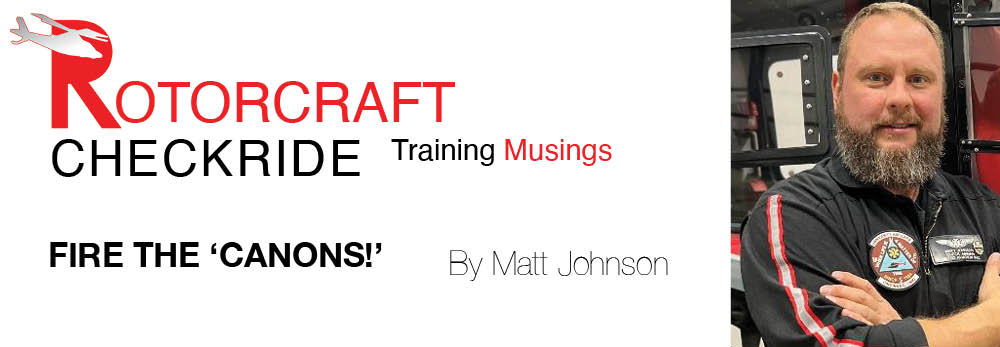|
Oct
27
2023
|
|
Posted 2 years 70 days ago ago by Admin
|
|

It should come as no surprise that unintended entry into Instrument Meteorological Conditions (IMC) has plagued our industry sector for decades. Thankfully, wonderful organizations like the USHST, HAI, and others have relentlessly tried to curb the problem. However, at least weekly, I read a news blurb about another helicopter that crashed after the pilot “encountered diminishing weather conditions.” The certificate level and experience level of those involved in these accidents vary. Each of these tragedies begs questions: How did they get into that situation? Given the situation, were they prepared for it once they found themselves there? Obviously, these are rhetorical questions, given the outcome of the numerous news stories. Many factors can be deduced to explain this situation. Still, I think most would agree that properly learning the warning signs of potential IMC scenarios and how to adequately control the helicopter by reference to instruments is lacking.
Back in time
A quick history lesson: several years ago, my predecessor to this column, Randy Rowles, chaired a training working group committee that provided input for a regulatory change. The idea was to incorporate a certain number of hours into the commercial helicopter aeronautical experience requirements. That requirement landed in 61.129(c)(3)(i), and reads:
“five hours on the control and maneuvering of a helicopter solely by reference to instruments using a view-limiting device including attitude instrument flying, partial panel skills, recovery from unusual flight attitudes, and intercepting and tracking navigational systems. This aeronautical experience may be performed in an aircraft, full flight simulator, flight training device, or an aviation training device.”
It’s certainly, a great addition to the requirements but not an end-all/be-all for eliminating IMC-related accidents. Consider this: private airplane requirements include three hours of instrument training. And while the majority of small general aviation airplanes are “instrument-equipped,” times have changed and brought about more advanced avionics and autopilots in smaller helicopters as well.
Good Intentions
The intentions were good, but it didn’t take long for a hiccup. In 2011, an LOI (Letter of Interpretation-Theriault) was issued by FAA Legal Counsel. The request for legal interpretation was initiated because of the language used in 61.129(c)(3)(i). While the first part was crystal clear, the second statement wasn’t so clear. That second part reads, “this training may be performed in an aircraft, full flight simulator, flight training device, or an aviation training device.” The word “aircraft” created a lot of confusion.
The LOI stated: “Yes, the five hours of aeronautical experience for meeting instrument
requirements for a commercial pilot certificate may be accomplished outside of a helicopter, in
an aircraft, flight simulator, flight training device, or an aviation training device.” This resulted in many commercial helicopter applicants obtaining their “five hours of instrument time” in an airplane in order to meet the 61.129 requirements, and this was very unfortunate. That wasn’t the intent of the regulation when it was published in 2009; the objective was to better prepare applicants for IIMC situations in a helicopter.
Fast Forward
Thankfully, albeit many years later, another legal interpretation request was made (Pratt) about 61.129(c)(3)(i). Specifically, the requester asked whether the five hours of instrument training required for a commercial pilot certificate with a rotorcraft category and helicopter class rating could be accomplished outside of a helicopter, specifically in an aircraft, flight simulator, flight training device, or an aviation training device that does not replicate a helicopter. Essentially, it was the same question that had been asked in 2011.
In this most recent LOI (August 2022), the Office of Chief Counsel stated that the previous interpretation was incorrect. For those lovers of legal phrases, this was found to be on the basis of “cannons of construction.” This LOI stated:
“By applying canons of construction, when § 61.129(c)(3)(i) prescribes an aircraft as an option to perform the five hours of training on the control and maneuvering of a helicopter, its context is with respect to a helicopter, a device used for flight in the air. Moreover, a pilot cannot control and maneuver a helicopter outside of a helicopter itself, or without a full flight simulator, flight training device, or aviation training device that replicates a helicopter. Therefore, when § 61.129(c)(3)(i) is read in the context of paragraph (c) in its entirety, the FAA interprets the last sentence of 61.129(c)(3)(i) to mean that the five required hours of aeronautical experience may be performed either in a helicopter, or through the use of a full flight simulator, flight training device, or aviation training device that replicates a helicopter.”
Additionally, it said, “Thus, in light of this finding, the FAA hereby rescinds the Theriault (2011) interpretation”.
Kudos to the Office of Chief Counsel; they corrected and got it right!
About the Author: Matt Johnson has been an FAA designated pilot examiner for over a decade, conducting exams ranging from Private to ATP and CFI. Additionally, he is a single-pilot IFR air medical captain and Part 135 instructor and check airman. He can be reached at [email protected] and via Twitter @HelicopterDPE
READ MORE ROTOR PRO: https://justhelicopters.com/Magazine
WATCH ROTOR PRO YOUTUBE CHANNEL: https://buff.ly/3Md0T3y
You can also find us on
Instagram - https://www.instagram.com/rotorpro1
Facebook - https://www.facebook.com/rotorpro1
Twitter - https://twitter.com/justhelicopters
LinkedIn - https://www.linkedin.com/company/rotorpro1